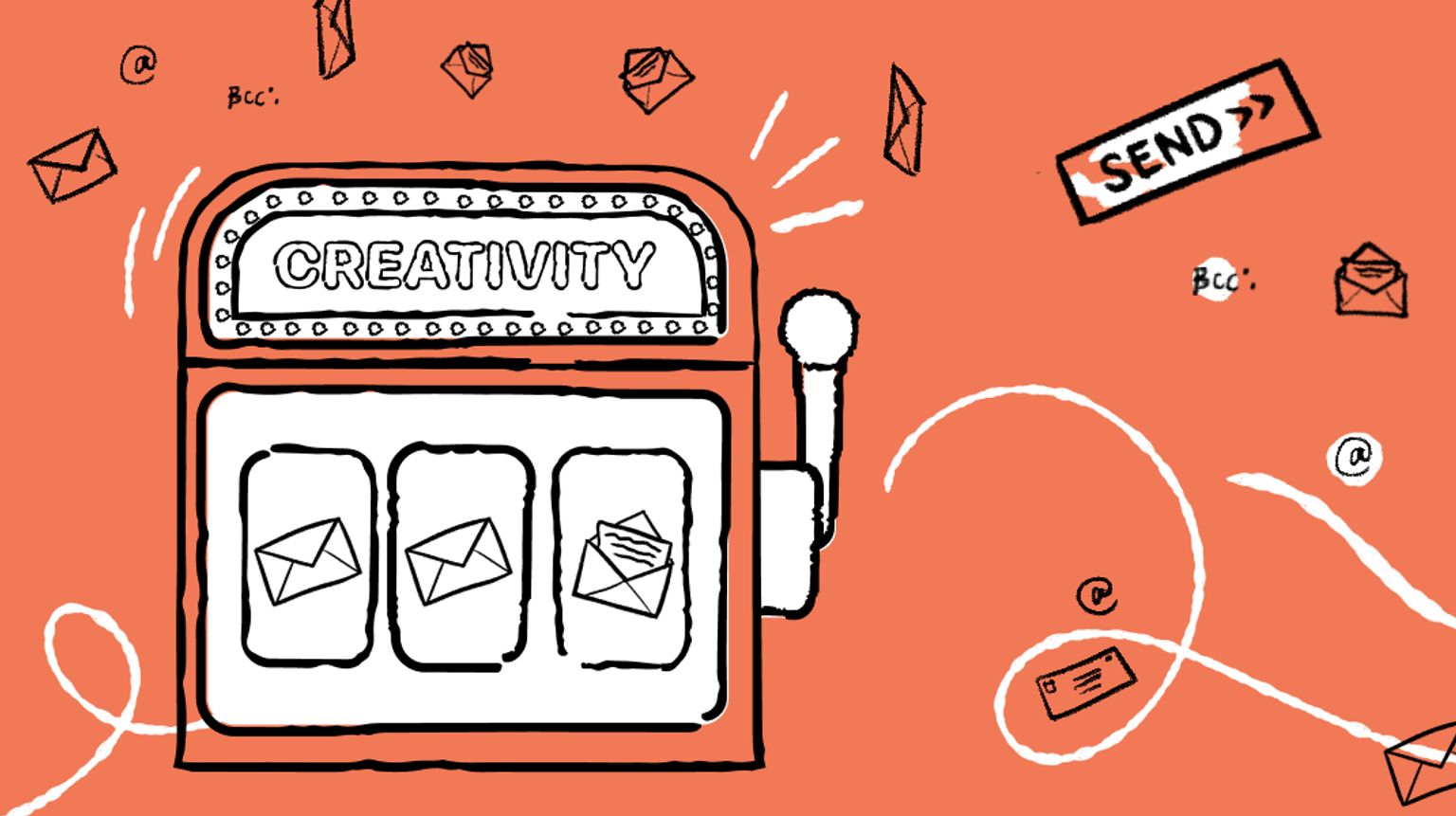
Summary
Unlock the power of creativity in email marketing with Knak's guide: Learn to captivate your audience and achieve the email jackpot effectively.
Getting attention in your customer’s inbox is harder than ever today, thanks to high volumes and stricter ISP rules on which emails make it to the inbox.
That’s why creativity plays such an important role in gaining and holding your customer’s attention. It’s not enough to have the latest email technology. It isn’t even enough to follow best email practices, like a recognizable brand name, a subject line that tells subscribers what’s in the email, and a preheader that gives them yet another reason to open the email.
As poker players say, that’s table stakes. It gets you into the game but isn’t enough to keep you there. Creativity in how you approach your email program is what will keep you in the game, hand after hand, and lead you to the email jackpot.
How creativity in email can set you apart
Creativity isn’t just having your subscribers recognize your brand name in the inbox. It’s the spark they feel when they see your name. It’s a subject that intrigues as well as tells. It’s a message that shows you put care, thought and consideration into even your ordinary, everyday messages.Knak Co-Founder and COO Brendan Farnand described creativity in his recent blog post as “the elusive X Factor that allows you to differentiate yourself.” That X factor can show up in what your subscribers see in the message as well as the unseen strategy you use to structure your campaigns or the tactics you use to create each message in the campaign.
How creativity can guide you to better email marketing
The first step in understanding how to employ creativity in your email marketing is to recognize how the email channel itself differs from your other channels.
Email is a push channel, meaning you decide when to send messages to your subscribers and customers. We email marketers don’t have to wait for someone to find us in search – we’re as close as the inbox!
It’s also an intensely intimate channel. The inbox is a tete-a-tete between your brand and your customer. Thoughtless use of the channel can damage this relationship quickly, even permanently.
Employing creativity in tune with your brand, your objectives and your customers’ wants and needs helps you exercise that power responsibly. I call this “helpful marketing,” which sees email as benefiting both customers and your brand.
When you help your customers achieve their objectives – such as solving a problem, answering a question, showing them what’s possible – they will help you achieve yours, like sales, revenue, engagement and loyalty.
Five tips for using creativity in email
Marketing is both art and science. The science part gets most of the attention these days with the focus on data, tools, tactics, the shiny objects that are fun to play with. But there’s an art to marketing – the human element – and that’s where creativity comes into play.
Creativity in email is more than clever copywriting or gorgeous images. It’s more than the latest technology or the highest levels of personalization. My five tips below will help you broaden your views of creativity and use it strategically to serve your customers and your email objectives.
1. Think creatively to overcome your challenges.
We usually call this “thinking outside the box,” but a truly creative approach to problem-solving doesn’t need a box. A good way to get started is with that most uncreative of tactics: make a list.
- Column A: List your greatest challenges, like acquiring new email addresses, increasing revenue from email, or keeping more customers active instead of burning out.
- Column B: List the conventional solutions to those challenges. Too many customers abandon their carts without checking out? Send an abandoned-cart reminder. Need to get more new subscribers to buy for the first time? Send a welcome message with an incentive.
- Column C: Abandon all conventional thinking. Ask yourself “How can I help my customers?” So, instead of sending one welcome message, what about creating a series of emails that are focused on converting them to being first-time buyers? In fact, why not name this series after its objective and name it First Purchase Program. It will help you to stay focused on the objective.
Simply following the rules won’t help you solve your unique challenges. Creative thinking tempered with attention to responsible email practices – Brendan’s “guardrails” – will point you in the right direction.
2. Stay focused on the customer experience.
Creativity doesn’t mean throwing all caution to the wind, or throwing something together randomly and seeing if it works. It means thinking of the customer first in everything you do, from strategy to tactics.
So many factors go into your customers’ experience with your brand. Email can help it or hurt it. Sending too many emails can burn them out. Sending too few makes your email program less important and less successful.
The sweet spot comes when you send relevant messages that address their needs at different points in their journey or relationship with your brand. Creativity doesn’t just mean dressing up the same old 20%-off promotion with a catchy headline or pretty images. It means looking beyond the conventional to think about how email can enhance your customer’s experience with your brand.
3. Design for conversions, not just aesthetics.
As I mentioned above, email creativity takes more than an attractive package. Your email has a job to do, and it’s usually to prompt your customers to go to a website landing page and convert. You are the Director of their customer journey.
Your design must support that objective in a creative way that nudges your customer to act. That’s a guardrail that keeps creativity working to serve your objective. Think of it like holding their hand and guiding them. Design the message with a narrative flow that leads the eye to the call to action button. This is one way to marry creativity to objective.
4. Look for inspiration everywhere, and build on it.
If you’re like most email marketers, you subscribe to all kinds of email programs – your competitors, brands you admire, your personal brand preferences and more. You can search for specific kinds of emails in databases like Really Good Emails, eDatasource, MailCharts, the FreshAddress Email Creative Archive and Pinterest.
You could also head over to our Email Gallery to grab inspiration from 50+ high-converting enterprise email examples spanning over 10+ campaign categories.
You can see what your peer and competitor brands are sending. You also can study their sending patterns to get a little competitive insight, too. All of these can fuel your creativity. You don’t want to copy them, though. Rather, take what you see and filter it through your own brand and customer situations to find an interpretation that works best for you.
5. Test and measure your creative approaches.
“Creativity” is not the same as “anything goes.” Testing and measuring – the science in the art and science of marketing – will show you whether your new methods give you a better uplift over more conventional treatments.
You will get best results when you adopt a scientific approach that incorporates a hypothesis tied to your campaign or program objective. It’s easy to do simple A/B testing on a subject line or call to action, but those results likely will apply only to that campaign. Aim higher and use hypotheses to test over multiple campaigns to gain statistical significance and long-term gains, and use control groups wherever necessary.
Conclusion: Stay focused on your objectives at all times.
In other words, avoid creativity for creativity’s sake. If you switch to a new email format or sending pattern, and your customers hate it (something that should come out in your testing and response tracking), go back to the drawing board and try again.
That’s one of the beauties of email – you’ll know almost right away if something doesn’t work out the way you planned. The other beauty of email is that you can pivot quickly to a new approach. You’re not redesigning an entire website!
Even when creativity leads you to a productive new path that scores with your customers and leads to more opens, clicks, conversions and goal achievement, you’ll still want to stay on top of it to fine-tune it as you learn more about your customers or as they evolve.
But with your objectives to guide you, you’ll be less likely to take a creative wrong turn.
Looking for inspiration for your next email campaign? Check out our Email Gallery to see 50+ B2B email examples spanning over 10+ campaign categories including Newsletter emails, Webinar invite emails, Product onboarding emails, Content download emails, and more.












